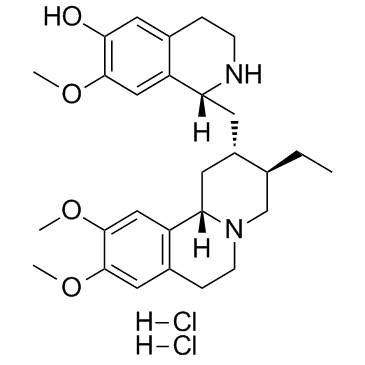5853-29-2
| Name | (-)-cephaeline dihydrochloride |
|---|---|
| Synonyms |
10,11,7'-Trimethoxy-emetan-6'-ol,Hydrochlorid
cephaeline dihydrochloride 10,11,7'-trimethoxy-emet-1'-ene-9,6'-diol Alangicine 10,11,7'-trimethoxy-emetan-6'-ol,dihydrochloride 10,11,7'-Trimethoxy-emetan-6'-ol,Dihydrochlorid EINECS 227-463-3 (-)-Cephaeline (dihydrochloride) |
| Description | (-)-Cephaeline dihydrochloride is an enantiomer of Cephaeline dihydrochloride. Cephaeline dihydrochloride is a selective CYP2D6 inhibtor with IC50 of 121 μM. |
|---|---|
| Related Catalog | |
| Target |
IC50: 121 μM (CYP2D6)[1] Ki: 54 μM (CYP2D6)[1] |
| In Vitro | CYP2D6 reveals the highest metabolic activity for the generation of 9-O-demethylEmetine, whereas this enzyme also shows a significant metabolic activity for the generation of Cephaeline. IC50 of Cephaeline against CYP2C9, CYP2D6 and CYP3A4 is over 1000, 121 and 1000 μM, respectively. Further experiments are performed to determine inhibition constants (Ki) for Cephaeline on the CYP2D6 and CYP3A4 activities Graphic analysis of Dixon plots at various Cephaeline concentrations for each of the two CYP enzyme assays yield Kis of 54 and 355 μM for CYP2D6 and CYP3A4, respectively[1]. |
| Kinase Assay | Cephaeline is dissolved in methanol to give concentrations of 0.1, 1, 10, 100 μM (only theophylline-O-demethylase activity with Cephaeline; 0.0985, June 2001 679 0.985, 9.85, 98.5 μM) [1]. Human liver microsomal protein is incubated with the selected marker substrates in the absence and presence of above concentrations of Cephaeline or Emetine (1-100 μM, only theophylline-O-demethylase activity with Cephaeline; 0.0985—98.5 μM, final concentration). Incubation conditions are chosen such that the product formation is linear with respect to both incubation times and protein concentrations, with substrate concentrations being at or below the Km for each enzyme. The effects of furafylline, sulphaphenazole, tranylcypromine, quinidine, and ketoconazole, selective inhibitors of CYP1A2, CYP2C9, CYP2C19, CYP2D6 and CYP3A4, respectively, are also determined in the same microsomal samples to provide comparisons with inhibitory potentials (IC50) of Cephaeline and Emetine towards the individual CYP form. The Ki s for Cephaeline and Emetine are determined by using the same pooled microsomal sample. This is achieved by varying the initial substrate concentrations (bufuralol 8, 16 and 32 μM; testosterone 45, 90 and 180u M) and using several inhibitor concentrations of 10, 50, and 100 μM. The Kis are estimated by graphic analysis of Dixon plots. These values are subsequently used as initial estimates for the nonlinear least-squares regression analysis[1]. |
| References |
| Molecular Formula | C28H40Cl2N2O4 |
|---|---|
| Molecular Weight | 539.53 |
| PSA | 63.19000 |
| LogP | 5.70910 |
CHEMICAL IDENTIFICATION
HEALTH HAZARD DATAACUTE TOXICITY DATA
|
| RIDADR | 1544 |
|---|---|
| Packaging Group | III |
| Hazard Class | 6.1(b) |
